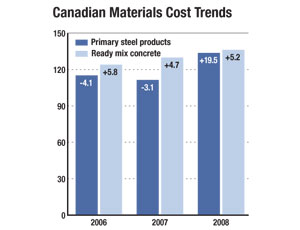Although the U.S. credit crisis has spread north of the border, Canada’s tighter regulations and healthy financial system are insulating it from the more severe repercussions seen in the U.S. However, Canada cannot shield itself from the growing recession in the U.S.
The hemorrhaging U.S. auto industry could wreak havoc in southern Ontario’s industrial base. The Canadian housing market also has taken a turn for the worse, although not as severe a downturn as in the U.S. market. Exports, long a source of strength for the Canadian economy, are on the decline due to the stronger Canadian dollar and weaker global demand. Finally, commodity prices, which up until a few months ago were providing a boon for the western provinces, are being threatened as global oil prices tumble from last summer’s record peak.
With this growing list of threats to its economy, the Canadian construction market is forecast to decline 10% next year, to $66 billion Canadian dollars, according to a forecast released earlier this month by McGraw-Hill Construction Analytics, which, like ENR, is a part of the McGraw Hill Cos. Measured in U.S. dollars, the Canadian construction market is expected to decline 16% in 2009, to $58 billion, following this year’s 1% decline, MHC Analytics predicts. Like its U.S. counterpart, the Canadian construction market is coming off of an historic high, which included four consecutive strong double-digit annual gains between 2004 and 2007.
Single-family housing permits are expected to decline 11% this year, to 103,271. MHC Analytics predicts next year that permits will fall below 100,000 and remain there until 2011.
The weak housing market has undercut lumber prices, which were down 7.4% from a year ago, according to Statistics Canada’s cost indexes, which are current through October. This marks the third consecutive year that Canadian lumber prices have fallen more than 7%.
The nonresidential building market is expected to decline 15% in 2009, following a 4% increase in 2008 and a 21% increase in 2007, according to the MHC Analytics forecast. The market declines in 2009 will be across the board, including annual declines of 17% for commercial buildings, 19% for industrial work and 10% for institutional buildings.
The widest market swing forecasted by MHC Analytics is in the institutional building markets. The forecast calls for hospital construction to tumble 13% in 2009, after climbing 32% this year. Likewise, school construction will go from a 17% increase this year to an 8% decline in 2009, while the market for government buildings swings from a plus 18% to a negative 22%.
In general, Canadian material prices are following trends south of the border, in the U.S. Through the first 10 months of this year, steel prices in Canada were up 19.5% over a year ago, after falling 3.1% in 2007 and 4.1% in 2006. During the same period, asphalt prices increased 47% above 2007’s level, while concrete prices posted a 5% increase, according to Statistics Canada’s cost indexes.



Post a comment to this article
Report Abusive Comment